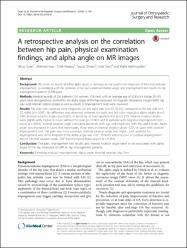| dc.contributor.author | Güler, Olcay | |
| dc.contributor.author | İşyar, Mehmet | |
| dc.contributor.author | Karataş, Dilek | |
| dc.contributor.author | Örmeci, Tuğrul | |
| dc.contributor.author | Çerçi, Halis | |
| dc.contributor.author | Mahiroğulları, Mahir | |
| dc.date.accessioned | 10.07.201910:49:13 | |
| dc.date.accessioned | 2019-07-10T20:01:25Z | |
| dc.date.available | 10.07.201910:49:13 | |
| dc.date.available | 2019-07-10T20:01:25Z | |
| dc.date.issued | 2016 | en_US |
| dc.identifier.citation | Güler, O., İsyar, M., Karataş, D., Örmeci, T., Çerçi, H. ve Mahiroğulları, M. (2016). A retrospective analysis on the correlation between hip pain, physical examination findings, and alpha angle on MR images. Journal of Orthopaedic Surgery and Research, 11. https://dx.doi.org/10.1186/s13018-016-0476-9 | en_US |
| dc.identifier.issn | 1749-799X | |
| dc.identifier.uri | https://dx.doi.org/10.1186/s13018-016-0476-9 | |
| dc.identifier.uri | https://hdl.handle.net/20.500.12511/3254 | |
| dc.description | WOS: 000391330200001 | en_US |
| dc.description | PubMed ID: 27846909 | en_US |
| dc.description.abstract | Background: We aimed to search whether alpha angle, a radiological clue used in the diagnosis of femoroacetabular impingement, is correlated with the presence of hip pain, internal rotation angle, and impingement test results on hip impingement patients (CAM type). Methods: Medical records of 334 patients (156 women, 178 men) with an average age of 33.8 +/- 8.4 (range 20-50) years were retrospectively studied for the alpha angle of the hip measured on magnetic resonance images (MRI). Hip pain and internal rotation angles as well as results of impingement tests were reviewed. Results: Hip pain was reported more frequently on the right side (n = 35, 10.5%) compared to the left side (n = 22, 6.6%) (p = 0.047). No difference was observed between the right and left sides regarding alpha angles (p = 0. 145), internal rotation angles (p = 0.637), or positivity of impingement test (p = 0.210). Internal rotation angles were significantly higher in cases without hip pain (p < 0.001) and in patients with negative impingement test result (p < 0.001). Internal rotation angle correlated positively with age and negatively with the alpha angle. Alpha angle was increased in cases that report pain, those with an internal rotation angle <20 degrees, or cases with positive impingement test. The pain was more common, internal rotation angle was higher, and positivity for impingement was more frequent if the alpha angle was <55 degrees. Patients with hip pain or positive impingement test or internal rotation angle <20 degrees had increased alpha angles (p < 0.001). Conclusions: The pain, impingement test results, and internal rotation angle seem to be associated with alpha angle of the hip measured on MRI in hip impingement patients. | en_US |
| dc.language.iso | eng | en_US |
| dc.publisher | Biomed Central Ltd. | en_US |
| dc.rights | info:eu-repo/semantics/openAccess | en_US |
| dc.rights | Attribution 4.0 International | * |
| dc.rights.uri | https://creativecommons.org/licenses/by/4.0/ | * |
| dc.subject | Femoroacetabular Impingement | en_US |
| dc.subject | Alpha Angle | en_US |
| dc.subject | Internal Rotation | en_US |
| dc.subject | Hip | en_US |
| dc.subject | Pain | en_US |
| dc.title | A retrospective analysis on the correlation between hip pain, physical examination findings, and alpha angle on MR images | en_US |
| dc.type | article | en_US |
| dc.relation.ispartof | Journal of Orthopaedic Surgery and Research | en_US |
| dc.department | İstanbul Medipol Üniversitesi, Tıp Fakültesi, Cerrahi Tıp Bilimleri Bölümü, Ortopedi ve Travmatoloji Ana Bilim Dalı | en_US |
| dc.authorid | 0000-0002-0022-0439 | en_US |
| dc.authorid | 0000-0001-9052-4411 | en_US |
| dc.authorid | 0000-0001-8532-4917 | en_US |
| dc.authorid | 0000-0002-7794-9308 | en_US |
| dc.identifier.volume | 11 | en_US |
| dc.relation.publicationcategory | Makale - Uluslararası Hakemli Dergi - Kurum Öğretim Elemanı | en_US |
| dc.identifier.doi | 10.1186/s13018-016-0476-9 | en_US |
| dc.identifier.wosquality | Q2 | en_US |
| dc.identifier.scopusquality | Q1 | en_US |



















